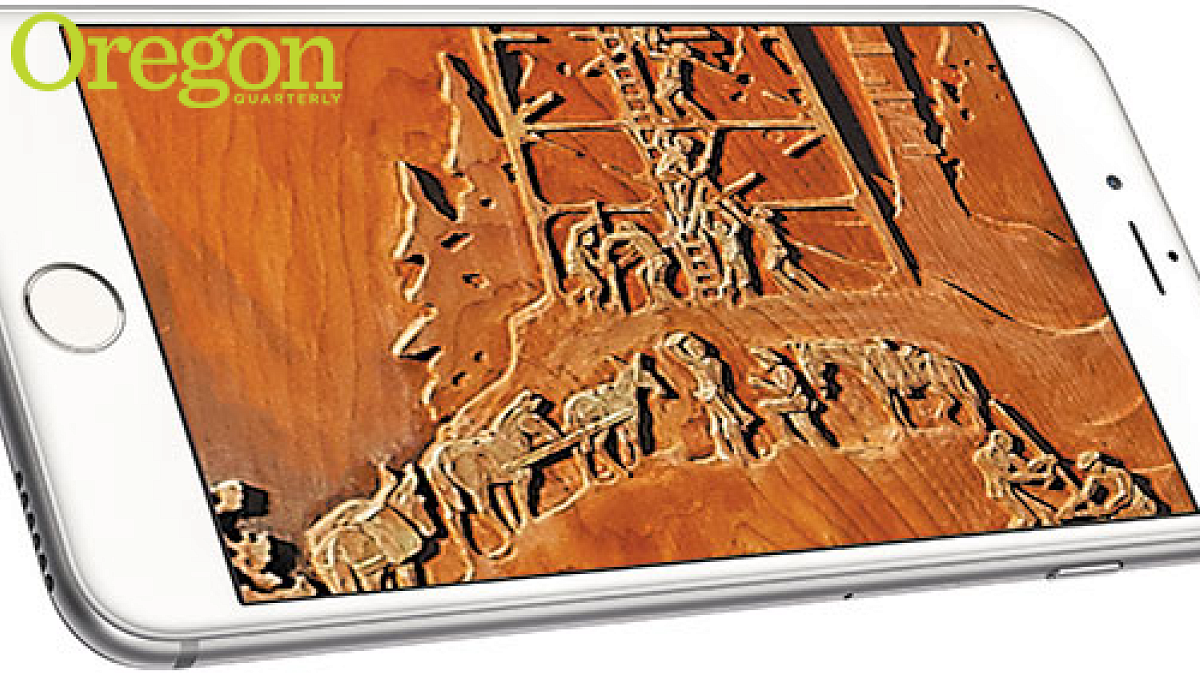Look closely at the right panel of a triptych in the Paulsen Reading Room at the UO’s Knight Library and you’ll see pack mules and workers carved into cedar. The piece, titled Below the Spires of Three-Fingered Jack, depicts a Civilian Conservation Corps crew building a lookout tower.
Walk over to Allen Hall and you’ll notice nine small squares between the first- and second-story windows bearing sculpted emblems that an architect in the 1950s mounted to tell the history of printing.
“Buildings are part of our culture,” says Edward H. Teague, head of the Architecture and Allied Arts Library on campus and the man responsible for bringing the architectural history of the university to life through his work on the website Building Oregon. The site was created through a collaboration between the UO libraries and Oregon State University coders, who created the open-source software.
A passion for the built environment documented in the collections of UO historian Marion Dean Ross, preservationist Michael Shellenbarger, and architect C. Gilman Davis inspired Teague to create a searchable online database that provides approximately 25,000 historical images and related details, including building dates and architectural styles. The collection includes decades of university history, providing access to information that enriches the architectural experience for the casual enthusiast. Here for a Ducks game? Load Building Oregon in your mobile browser and study the architectural elements of Autzen Stadium. Out and about in Eugene with your family? Use the site to delve into the history of the John G. Shedd Institute of the Arts, an example of Georgian Revival architecture, or study the elements of art deco at the post office downtown through dozens of photos on the site.
Teague holds out one slide, a color image with a description scribbled almost illegibly below it. “The hard part was cataloging them,” he says. “I had to verify what’s on each slide, definitely the most intense part of this project.”
As a librarian at the University of Florida, he published visual surveys of that school’s architecture. He relocated to the UO in 2001 with an interest in psychogeography. “Something unknown becomes ‘familiar’ by habit, not by any particular knowledge,” he says. “More knowledge deepens your experience of a place.”
Research for his award-winning electronic publication, The Architecture of the University of Oregon: A History, Bibliography, and Research Guide, piqued his interest in how best to use the UO’s thousands of gift slides reflective of work done by faculty experts on Pacific Northwest architecture.
A financial gift from School of Architecture and Allied Arts alum Jean Gillett, BS ’39, allowed Teague to outsource the digitization of about 14,000 images. A librarian at OSU, with whom he’d been collaborating on an Oregon digital database, proposed a mobile architectural website. “The idea,” he explains, “was to create this site so that wherever you are, you can see if there’s a historical building with images and data. Now, the primary database, the mobile version, and the research guide have a synergistic relationship.”
Associate Professor Julia Simic, metadata and digital production librarian, credits Teague as almost single-handedly responsible for Building Oregon, one of the university’s most popular digital collections. “People will drop us notes and say, ‘Hey, this was where my grandfather lived,’” she says. “It’s just really exciting to have that kind of interaction.””
Teague describes his walk from the EmX stop south through campus with an eye for both history and beauty. “Villard is my favorite building,” he says. “The style’s rare, with all of these ornate decorative elements. The Lillis complex straight ahead. It’s really well done; you can see right through it to Knight Library, which is regarded as a Depression-era masterpiece.”
He hopes the mobile website will inspire people to appreciate both campus structures and the landscaping that surrounds them. “The buildings are nicely featured with the quadrangles and trees and walkways,” he says. “You get a good understanding of what the Office of Campus Planning, Design, and Construction has done.”
In a room in one corner of the Architecture and Allied Arts Library, Teague stands among file cabinets and boxes of old slides, most of them images of Oregon buildings with notes scribbled under each film square. He studies one slide for a long moment, then reluctantly replaces it in the box.
“It’s wonderful going through these,” he says, and then laughs. “I’d better stop.”
Experience Building Oregon at buildingoregon.org.
—By Melissa Hart
Eugene-based freelance writer Melissa Hart is the author of the memoir Wild Within.


